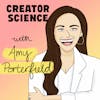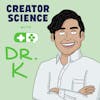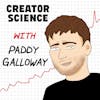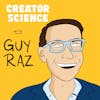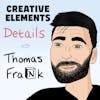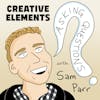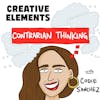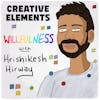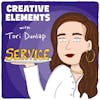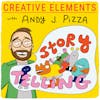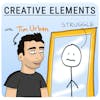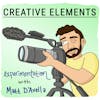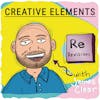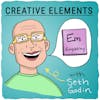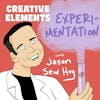
#115: Jason Sew Hoy of Supercast – How and why to create a premium podcast subscription
Play EpisodeJason Sew Hoy is the cofounder and CEO of Supercast. He was previously COO & Chief Growth Officer at 99designs.
WATCH
▶️ Watch this episode on YouTube
***
EPISODE DESCRIPTION
Jason Sew Hoy is the cofounder and CEO of Supercast. He was previously COO & Chief Growth Officer at 99designs.
Supercast is a podcast subscription platform for thousands of podcasters, networks, and publishers. Their top 10 podcasters earn $12+ million a year directly from their listeners.
In this episode, we talk about Jason’s path to Supercast, when a premium podcast subscription makes sense, how to create good incentives for subscribers to pay, and why none of this has been possible without Experimentation.
Full transcript and show notes
Follow Jason Sew Hoy on Twitter
TIMESTAMPS
00:12 - Creator Ecosystem Bird’s Eye View
00:34 - Today’s guest
01:02 - Jason’s Journey To 99designs
02:16 - Jason Saw The Power Of Podcasting
02:50 - What We Learn Today
03:30 - The Unusual Beginning’s of 99designs
08:26 - Creator vs Creative
14:12 - Tim Ferris Inspired Jason’s Interest In Podcasts
16:19 - Jason Meets Andrew Wilkinson and Sam Harris
16:43 - Patreon Problems Needed Solutions
17:30 - Start Of Supercast
18:29 - Money Behind A Huge Podcast Launch
21:37 - Why Breaking Points Blew Up
23:06 - How Can I Sustain Creating Bonus Content?
24:16 - Supercast Q+A Feature
25:13 - Best Trick To Growing A Paid Community
29:39 - Is Ad Free Enough To Convert a Free Listener?
31:19 - Is 5% Conversion Rate The Standard?
32:58 - Teams Behind Successful Podcast Creators
34:28 - When To Monetize Your Podcast
40:09 - Best Incentives to Convert Free Listeners to Paid
44:16 - How To Price A Premium Membership
46:24 - Monthly vs Yearly Pricing
***
CONNECT
🙏 Make a guest or mailbag request
📝 Check out our curated Playlists
***
SPONSORS
💼 View all sponsors and offers
***
SAY THANKS
💜 Leave a review on Apple Podcasts
***
PODGLOMERATE NETWORK
This show is a part of the Podglomerate network, a company that produces, distributes, and monetizes podcasts. We encourage you to visit the website and sign up for our newsletter for more information about our shows, launches, and events. For more information on how The Podglomerate treats data, please see our Privacy Policy.
Since you're listening to Creative Elements, we'd like to suggest you also try other Podglomerate shows surrounding entrepreneurship, business, and careers like Rocketship.fm and Freelance to Founder.
Learn more about your ad choices. Visit megaphone.fm/adchoices
Jason Sew Hoy 00:00
They got 10,000 subscribers in the first two days.
Jay Clouse 00:03
Paid subscribers?
Jason Sew Hoy 00:04
Paid subscribers.
Jay Clouse 00:06
Wow.
Jason Sew Hoy 00:06
Paying $10 a month so that is, you know, a million dollars.
Jay Clouse 00:11
Hello, my friend welcome back to another episode of Creative Elements. Most weeks on the show I'm speaking to an individual creator about their individual path. But sometimes I have the opportunity to talk to somebody who has a bird's eye view of what a lot of creators are doing at the same time. And so through their lens through them, we're able to learn something that applies to us, too. And that is the case for today's guest, Jason Sew Hoy, the co-founder and CEO of Supercast. Supercast is a podcast subscription platform that helps podcasters networks and publishers earn money directly from their listeners, the top 10 podcasters on Supercast earn more than $12 million directly from their listeners. Now, Jason has a background in computer science. That's what he graduated university with. But after graduation, he took a slightly different path than you might expect.
Jason Sew Hoy 01:02
Coming out of university I joined a multinational, called Unisys, and was asked, you know, like, do you want to go down the engineering route or do you want to go down kind of more the business route, and I chose business because I had wider interests. And from very early on, you know, at school, I studied some accounting, you know, didn't speak any papers. I did some, you know, kind of like genetics and biotech paper so I like broader interests.
Jay Clouse 01:27
Exploring those interests served Jason well, he started working at a company that gave him an opportunity to to learn and an opportunity to lead and that opportunity led to an even bigger opportunity.
Jason Sew Hoy 01:38
And I joined a company called SitePoint to lead an agency division as as the GM. Within that business, I took that role thinking okay, well, I know how to lead an agency, I know how to do take sales, but there is something else going on at this, this kind of like the SitePoint business, and surely something will come of it.
Jay Clouse 01:57
What came after, as you'll soon hear is the creation of 99designs, a global design marketplace. 99designs has had a lot of success, they have more than 1.6 million designers on the platform. And if you've heard of 99designs, you just may have heard of them on a podcast, they were early on in podcast advertising, and they advertised a lot on the Tim Ferriss show in particular.
Jason Sew Hoy 02:21
I myself, you know, became an avid Tim Ferriss listener, and I started adopting his workout regime and I started adopting, you know, the, the low carb diet. And you know, before I knew it, I had spent, you know, like tens, and hundreds of hours, you know, kind of like listening to his content and just, you know, felt that draw that influence that you know, someone like that you can have on your life when, when you really tune into it to a podcast
Jay Clouse 02:47
That started Jason down the path of studying podcasting. So in this episode, we talk about Jason's path to SuperCast, when a premium podcast subscription makes sense, what type of incentives to create to get someone to pay for a podcast, and why none of this is possible without experimentation. I'd love to hear your thoughts on this episode. As you listen, you can find me on Twitter or Instagram @jayclouse or leave a comment on YouTube, be sure to subscribe to the channel, if you have not already. That's enough of me, let's talk with Jason.
Jason Sew Hoy 03:30
But the reason I joined SitePoint is because they had so many other interesting things going other side, they had a publishing division, you know, they were producing all of these books. They had partnerships with O'Reilly, for example. And they were creating all of these books and tutorials around like how to build your first website with PHP and MySQL. So that was pretty interesting. But then they also had this forum with I think, at the time, you know, like, when I looked at the website of sitepoint.com, I had this form, and it said, 874,336 members, subscribers, and I was like, what is that? And so I dived into it. And in this forum, there was just like this sprawling community of web developers and web designers who are just trying to figure out ways to be better at their craft, you know, they are in there, you know, on a daily basis, you know, talking to each other. And, you know, just just challenging each other and sharing information. You know, that forum was actually pivotal to a number of different businesses that would spin out of the wider SitePoint umbrella, the way 99designs came about is that within this kind of like really organic forum, designers in one particular forum thread just started competing against each other to prove who was the better designer. So it was just like this really fun way for them to level up their skills, challenge each other. And, and, you know, just play around with tools. So one designer would come up with a fictional brief, you know, like I posted and say, hey, you know, like, how about we design brochures these days for a girl Every company, and and the other designers, you know, two or three would battle it out. And you know, there would be various forms, they call it Photoshop tennis at one stage where, you know, basically you would pass around a file and see who could, you know, like, make it better in different ways. And along came one day, this person who said, Look, I'm a web designer, I design websites, but one of my clients has asked me for a logo, I don't do logos, here's the brief, I'll put up $100, and whoever can design me the best logo gets the money. And so these designers loved it like that, you know, all of a sudden, you know, they were kind of like being offered money for something that they were doing for fun anyway, so this little forum thread just started to blow up as a way to get, you know, like, lots of creative creative ideas for things like logos in a really affordable way. And, you know, in a way that, you know, just flipped the traditional design model on its head, you know, you didn't have to try to pick a designer based on their portfolio, you know, like, it was just, you know, kind of like, show me, show me what you got. And so it started, you know, all this organic traffic started coming to this forum thread. And so before we even knew the term MVP, minimum viable product, you know, like, what we did at type one was, was just to say, well, maybe there's a business here, you know, and, and so the first step was simply to lock that forum thread. So we liked the forum thread, I made it $10, to post a job a request into that thread and thought, well, this will probably kill it. But it didn't kill it, it just validated that all of a sudden, this was a waste to actually go get design and started, you know, like, accelerate even more. So we doubled the price to $20. And more and more people came, you know, like, now businesses were coming, wanting, you know, actual assets created. And so, you know, several more steps later, it was clear that this was a separate business opportunity. And so that forum thread became a tab on site point. So it became like sci-fi design contests. And then the next iteration was to split it out of this as its own separate brand. And that's when it became 99designs.com.
Jay Clouse 06:54
Wild. And at that point, did you jump in as the executive in charge of operating that business?
Jason Sew Hoy 07:00
So basically, I've been at, you know, SitePoint for three months, the founder had just decided, okay, this is a real thing, I need to build a team around it, he knows, you know, like, kind of, he's very self aware of like, his skill sets, and what what gets him interested, he knows, that once suddenly gets to about four or five people, he's got to find someone else to run the business because, you know, he starts to catch kind of, like, you know, lose it worth, like managing projects and all that sort of stuff. It's just not not as bad that's when I came on board basically, as the gym, you know, COO of the business, it was a wild ride, you know, as it no no designs for over a decade, you know, multiple, kind of like business lines and opportunities within that expanded the team, you know, from just being bootstrap for the first three years, predominantly based in Australia to, you know, having a big presence in California, and then also Berlin, raising, you know, venture funding with Accel Partners three years in, and then ultimately, leading to an acquisition by Vistaprint, just just a couple of years ago.
Jay Clouse 07:56
That's amazing. I would have never guessed that was the origin story for 99designs that have evolved organically out of this forum as friendly competition that people are having with each other, just for fun and for competition. That's so interesting that you notice that, that it evolved, I mean, this is this is really talking to the power of community, which I'm sure we'll talk about here soon. But to notice that evolving, and then say there's something here, let's play around with this and see where it could lead. Just fascinating origin story, right? Here's a question that I don't get to ask a lot of people but I feel like you would have some unique insight into I feel a lot of tension between the identity phrases of creative as in like a creative and creators. Today with SuperCast you work with a lot of creators, 99designs probably felt a lot more like creatives and you know, the the early 2010s. How do you think about those two words? Are those two different types of people to you, because to me, it kind of seems like they might be, but it's hard for me to differentiate.
Jason Sew Hoy 08:56
You know, there's a way of looking at creatives that says, hey, you know, like, you come with a brief or you give them you know, kind of tell them a little about their business, and they go wild with their creative ideas, you know, like, and they throw you a whole lot of stuff that you in no way could have done on your own. And, you know, like you contribute to the process. And you come out, you know, with a logo that just looks you know, like an incredible, you know, like, that's one way of thinking about a creative but even within that spectrum at 99designs, there's you know, there's a whole range of, you know, kind of like creatives within that umbrella. So you get people that are more than artists type you know, like that, that you know, like sure they will get some inspiration from like the business that you have your business name, etc. But then, you know, they're more towards the Michelangelo end of the spectrum, right, where they will come up with something incredible that might fit your needs are might not fit your needs and you know, you might be able to bend them or you might not be able to bend you know, like and they're somewhat you know, like sit in, you know, kind of like how much inspiration they'll let you kind of like play. At the other end of the spectrum, there are the people that are just great at like graphic design execution, you know, like, they, they're not really, you know, like, gonna come up with that, you know, kind of artistic flair, but what they'll do is that, you know, they, they're really good at, you know, kind of pumping out iterations and executions, and, you know, like, more or less coming up with, you know, like, what you're asking for, visualized, you know, in kind of the form that you need it, I think, now that we think about, you know, kind of, like broadening out from like, graphic design, and all of the places that are created can, you know, kind of exist on the internet, the term creator, I think, you know, like, broadens significantly in the context of podcasters. It's just, you know, a lot looser a term anybody that, you know, is basically creating content these days, we bring under the umbrella of creator, you know, writers, podcasters, etc. And, you know, I guess, to your point, is an interviewer of an interview style podcast, you know, like, they do you think about them as a creative in that same sense, I think of it these days, as you know, like somebody that is that is creative, creating content. And so, yeah, I think it's like less connected to kind of like the purest art form of a particular medium.
Jay Clouse 11:15
Yeah, it's weird, I think about a lot just because my target audience are people who identify as creators. And what I find are there a lot of people who identify as creatives that don't quite identify as a creator, they don't know what that term really means. But it's kind of like a rectangle, square situation, in my experience, where creators identify also as creatives, but not all creatives identify as creators. But at the end of the day, whatever somebody identifies with as a creative or creator, they're making things they're solving problems with their creativity, they're making something whether it's for one individual, as a client, or for an audience, or for hopeful mass appeal. That's just interesting. The, I think, I think the term creator is still in its infancy a little bit, and people are becoming more aware of it more accustomed to it warming up to it, maybe. Yeah, it's, it's, it's an interesting struggle that I have with a show called Creative Elements Serving Creators.
Jason Sew Hoy 12:15
And I think it also, you know, like, has just opened up dramatically with how easy it is to create content, you know, on the on the internet these days, right? I mean, like, anybody can fire up Tiktok, or whatever, and start becoming a creator, right, you know, just just by virtue of the fact that they're putting content out into the world. So it makes sense that, you know, some of these terms are looser than we originally designed them for.
Jay Clouse 12:37
After a quick break, Jason and I talked about why he believes so deeply in podcasts and the opportunity for podcasters to earn money directly from their listeners. And later, we talked about the economics and incentives for creating a compelling premium podcast feed. So stick around and we'll be right back.
Jay Clouse 12:55
Welcome back to my conversation with Jason Sew Hoy. Jason has been building SuperCast for the last three years, and to dedicate three years of your life to podcast means that you probably have a deep love of the medium. So I asked Jason, where his appreciation for podcast came from.
Jason Sew Hoy 13:11
About halfway through the 99designs journey, actually, probably even earlier, this guy, by the name of Tim Ferriss, he came into contact with 99designs and and he expressed the frustration that the designers at his publishing company that were working on his second book, just, you know, weren't heading out of the park with the cover design concepts that they were sending him to. And so he wanted to use the platform to come up with some, some better designs, and, you know, really throw it out to the creative community. And so we worked with Tim to do that. And, you know, that's how the cover design for the four hour body actually came about. But then, you know, sometime after that Tim decided to launch a podcast when he did, you know, like, shortly after he said, he turned around to, to us and having worked with us before, and knowing that, you know, like we, you know, our core customer base was kind of, you know, entrepreneurs or people that were starting things, he asked us whether we would come on board as the first sponsor, and so, we leapt at the chance. And that show, you know, has become one of the has been, you know, since we started one of the most wonderful acquisition channels for new people launching, you know, design projects on designs for for a number of different reasons, you know, like, I mean, Tim has term, you know, like, I think it should be basically anything that, you know, he recommends, you know, his audience.
Jay Clouse 14:32
I think he refers to it as the hug of death.
Jason Sew Hoy 14:34
Right, right, right, right. And, you know, the second thing is, you know, but the fact that he had used the service meant that his raid, you know, like his endorsement for an ion Zaanse was just like, so authentic, he would talk about you know, basically all the cover designs, you know, like flying in and feeling like you know, kind of Christmas every time you know, and just so much creativity and so, you know, number one, it generated great business for For us, you know, I say so that was, you know, like where I experienced, you know, like just the the intimate connection that a host can have, you know, with their listener base in terms of like providing those those recommendations. And so, that was my first experience with you know, podcasting as a medium. And then towards the end of my time at nine designs I got, I got talking to Andrew Wilkinson, who heads a group called Tiny Up in Canada, but basically a family of, you know, internet companies, some of which, you know, kind of like, started in the design world. So Metalab, for example, prolific design agency dribble, you know, huge design network, you know, just a whole bunch of other, you know, wonderful companies as well. And he had started working with Sam Harris and Sam Harris had built up a big Patreon, but then, you know, I just basically decided, you know, that that was too clunky, you know, experience for most of his subscriber base, you know, they were going from listening to his podcasts, you know, loving, you know, his content, wanting more bonus content, and being willing to pay, but then kind of, like stuck in this experience where they were signing up for a Patreon account, and then, you know, after having done so, you know, looking at a wall that resembled Facebook, as opposed to just wanting to listen to more content, you know, and being in, you know, the podcast world. And so Sam wanted us to build you know, basically the founding team of supercars to build his own bespoke solution. And we did so and launched it to, you know, enormous success. And in doing so, got a front seat to you know, just how, you know, kind of how much money a podcast membership can generate a podcast subscription can generate, and, and a resembles, you know, the metrics resemble a great software business. And that's what kind of like blew our minds. And we thought, wow, this is just Sam's audience, you know, like, or is this something that, you know, is more widely applicable. And so, we worked with a couple of other podcasters, Peter Atea, and the health and longevity space, and Rhonda Patrick also just talks a lot about saunas and basically deconstructing, and keeping up to date with like, the latest in science and health research, to bring that, you know, to, to into layman's terms, and you know, how we can live healthier lives and their audiences both, you know, like, blew up as well in terms of like their memberships, and just transformed their ability to do more research and create like more incredible content for their, their communities.
Jason Sew Hoy 15:36
When you say that Sam's podcast on SuperCast, the premium version launched a tremendous success, can you quantify tremendous success a little bit to give people a taste of what is possible?
Jason Sew Hoy 17:38
Sam was the precursor to SuperCast. So that was him paying us on an agency basis to build out a subscription solution, which, you know, like Sam, that, uh, you know, owns and runs himself. But, you know, since Sam, you know, you know, a number of customers have launched on supercast. And so the example that I will give because I know, they're happy to meet with me to, you know, share these numbers is breaking points. And so breaking points was the precursor to breaking points was a show called Rising on the Hill, which is a, you know, DC media outlet, Crystal and Saga are theco-hosts of Breaking of the Hill of the Rising sorry, and they decided, you know, that they would go independent from the hill and start their own show called breaking points, which launched in June of last year, so nearly a year, they were going to be basically starting from zero, you know, it'd be a brand new YouTube channel, a brand new podcast that never done a podcast before, but they had, you know, kind of like, built, you know, kind of Instagrams and youtubes. And they would power that all with a supercar subscription. So you might find them on YouTube, you might find them a podcast, but either way to get, you know, kind of early access to the show, you would sign up on supercast. And you could consume that either in live video or audio form. And so when I say, you know, like, they launched his training, tremendous success, they got 10,000 subscribers in the first two days, paid subscribers, paid subscribers, wow, paying $10 a month. So that is, you know, a million dollars, you know, like, you know, in terms of like, annual revenue, like straight off the bat, which blew their mind like that they did not anticipate that whatsoever, you know, like, when when we had kind of, like, kicked around ideas and projections and estimates and things like that, you know, we'd kind of like model out and thought, okay, well, we might get that, you know, like, at the end of the first year, honestly, like, it was just, you know, wild seeing that number of subscriptions flowing in, you know, like within the first two days 40% of those paid annually. So they paid $100 upfront as opposed to the $10 monthly, and then they actually included a lifetime membership option as well for $1,500. Like $1,500 is a one off payment. And I think at this point, over 700 people have paid that for that lifetime membership.
Jay Clouse 19:53
That's crazy. So 700 people expect that they would be annual members for more than 15 years.
Jason Sew Hoy 20:00
Yeah, exactly.
Jay Clouse 20:01
Wow, that's a lot of trust in the creator. We're so early in this creator, economy, there aren't that many people that have been doing any type of creator business for 15 years.
Jason Sew Hoy 20:13
Right? So I actually think it's that particular part of it, I think it's less about the, you know, kind of like sizing up, am I gonna cure? Am I going to be a member for 20 years, you know, like, and
Jay Clouse 20:26
It's not the pure like financial side of it, it's them saying, like, I get so much value out of this, that I want to support you,
Jason Sew Hoy 20:32
Right.
Jay Clouse 20:33
in this way.
Jason Sew Hoy 20:33
Exactly. It's mission. It's, so they're, and you know, like to explain a little bit about, you know, kind of like, why that took off the way they did. They've really zeroed in on, you know, who their audience is, the makeup of, you know, Crystal and Saga is that from a political point of view Saga is on the right Crystal's on the left any given show, so they publish three times a week in the mornings. And it's news, and it's politics, and it looks a lot like a cable news show. And they very, they very specifically went after that. So that, you know, your I, for example, if we were sending a clip to our parents, and saying, hey, look at this, I told you inflation was gonna be going up, you know, like, our parents wouldn't dismiss it, because it looks like a YouTube show. It looks super professional, you know, they Saiga put a lot of money into designing his desk, his fair specs desk there. And because because they bring, you know, kind of that diversity of viewpoint, people really value the debate, which is often missing in mainstream media. And of course, you know, if you look at charts of trust in mainstream media, you know, it's fallen to all time lows, you know, like from, from a kind of widespread population point of view. And so that's what Crystal and Tiger really zeroed in on. And they said, you know, like, basically, we want our boss to be our audience, you know, we don't want to be at the whim of, you know, corporate sponsors, and all that sort of stuff. We don't want to be biased, and we want to bring you, you know, like that, that unbiased perspective. And so they're really kind of like, brought the listeners in to supporting that mission. And that is what I think has really resonated with people.
Jay Clouse 22:05
I'm looking at some of the things they're promising here. So they have ad free, uncut, so it's like the ad free version of the show. It sounds like they have exclusive reactions to each other's monologues right, weekly access to a premium only asked me anything episode, twice monthly exclusive, long form discussions, that's a lot of things. Is that typical for SuperCast users that are doing well to be offering five different perks to their premium members or do you see people offering fewer things? Because I think a lot of the people who consider this, one of the big concerns I have is can I sustain whatever it is that I need to promise to get people to follow through on purchasing a membership?
Jason Sew Hoy 22:48
Yeah, it's it's probably, you know, the biggest concern of creators, creators creators, and it's very fair concern. And, you know, what we try to do, you know, being the kind of like, the platform that supports creators is just a workout, you know, like, how we can guide them to not overcommit, like, the last thing we want them to do is like to have a double their, you know, creative workload. So that's why we built out you know, like to give you a, you know, kind of like record. So we look for opportunities, again, with a curiosity to build certain things to make it easier. So the AMA's, for example, that is powered by a specific function on supercast. We have an AMA portal, basically a page where as soon as someone becomes a member, they can submit questions, it'll, you know, kind of auto suggest questions that are already been asked, they can upload other people's questions instead. And then as a creator, you know, when you come to do those ama episodes, once a week, once every two weeks, you just kind of like, pick out three or four that you want to answer, record one episode, and then you can timestamp where the answers appear. So that, you know, there's there's basically a workflow, you know, and and it's not, it's not too much logistically for you to manage.
Jay Clouse 23:56
So for folks who were using this Q&A feature, are they making that episode only available to listen to, for paid subscribers or is it sometimes use as hey, paid subscribers can ask the questions, we released that episode for anybody to listen to.
Jason Sew Hoy 24:13
There's a trick, you know, basically to fueling the growth of your community. We use some of your premium content as teasers on your public feed. And so people like Sam Harris people like Peter, they do this extraordinarily well. And so what you do is you record an AMA episode let's call it you know, say say you know, ama episode number 30. And you choose of course, you know, which five questions you want to answer and say you spend an hour answering those questions. What you would do is you would put that on the private feed on SuperCast so that you know, all of the members get that immediately and also all the people that are voted or asked question would get email notified saying, hey, your question has been answered, but then you can also take the first say, five minutes 10 minutes 15 minutes, whatever you choose, and put a snippet of that onto your public feed, to give people a taste of, you know, like what they'll be getting, if they were a premium member, and then you know, kind of like cutting, you know, obviously, you know, when when the teaser finishes with a call to subscribe to the premium feed, to be able to ask your own questions or to be able to, you know, to continue listening. I think that's a really, really important point, because it also applies to a lot of you know, what you just listed out on the breaking points page, some of those five things that you mentioned, are actually not that difficult, you know, that they're not, you know, a ton of extra work. And the important thing is that they also provide a teaser of an opportunity to subscribe organically, that doesn't feel like an ad. And so to be more specific about that, the second point was the reaction to each other's monologues. And again, this this is something that crystallin and saga, you know that that was their idea, you know, like they really paid attention to what their audience values about the show. And the fact that there's two hosts, what happens is, each of them in every episode presents a monologue. So saga, for example, might do a five minute segment on GameStop, you know, everyone's wondering what's going on with GameStop. And, and he will do a five minute monologue, deconstructing all of that. And then after the monologue, he will turn to Crystal and say, okay, so what do you think Crystal, and so that's where you get into kind of the debate on the show, right. And at that point, on the public feed, is when it cuts off, and it says,
Audio playing 26:29
But we need your help. So if you can help us out by becoming a premium member today at breakingpoints.com, we're trying to change America for the better and the entire world. So what are you waiting for guys go to breakingpoints.com and sign up and help us build a new mainstream.
Jason Sew Hoy 26:44
You know, yes, you are missing out on a bit that you know, you'd like you would have loved. But you know, you have to have that little bit of tension there. You know, you have to have that healthy tension of all this is something you know, like I really wanted to hear, as well as you know, like the way to get it so that in every single episode, you remind people you know, like why they should sign up.
Jay Clouse 27:04
When we come back, Jason and I talk about the economics and incentives for offering a paid podcast subscription, and when you should start considering offering one for your listeners. So stick around and we'll be right back.
Jay Clouse 27:19
Hey, welcome back over the last couple of years, I've thought about offering a premium subscription for listeners of the show. But my hang up has been what am I providing those premium subscribers every week? Now the obvious answer is an ad free feed. So I asked Jason if offering an ad free feed is enough to attract paid subscribers.
Jason Sew Hoy 27:38
So you know, I think about these things in the context of conversion rate, you know, and ultimately, that means, you know, like, you know, if you have 10,000 listeners per episode, how many of those, you know, can you get over to being paid subscribers. And so, you know, like, just to really, I guess, explain the model, we don't really have anybody that just slams the paywall down hard, and says, okay, this is not going to be a free podcast anymore. Like you need to pay, you know, to listen to anything, and we certainly wouldn't, wouldn't recommend that either. Because, you know, the free podcast, one, you know, like, this is, this is what you built today, you know, like, and this is what lessons are coming for. And then secondly, it's also the top of your funnel, that's how you continue to grow both your free and your paid audience and future. So it'd be short sighted, you know, to slim the audience. But rather, you know, like, we think about this idea of, you know, what a 5% of your audience were to pay you $10 a month, what a 5% of parents will pay you $10 a month, and that gets out a few things, you know, like, it's a monthly subscription. But, you know, like, it's, it's really for the 1000 true fans, you know, to quote Kevin Kelly's model, and, and it means that 95% of your audience can still just enjoy your content for free, maybe they're still trying it out, maybe they just discovered it today. Or maybe, you know, they just can't afford it. And you know, like, or, okay, you know, like listening to the free content. But for the people that do love you and want to support you, or want to get that extra bonus stuff, they have the ability to upgrade themselves, you know, into that higher paying thing where you're earning much, much better return than even, you know, kind of like, advertising CPM rates.
Jay Clouse 29:18
Is 5% the bar that you give people to shoot for, or expect when they put in place a premium feed?
Jason Sew Hoy 29:26
So we generally quote between two and 7% The way I catch it is and going back to your original question, if you do the easy lift stuff, like add free, like early access, for example, maybe, you know, restricting access to your back catalogue, I went into support, you know, like, if you just have a one or a couple of those things, you would be you know, maybe even 1% You know, 1% conversion rate one to 2%. So it'd be at the bottom end of that spectrum. But as you start to overlay bonus episodes, AMA's maybe access to a private Slack community so Cool community, Slack group paid newsletter so willing to because we've also built on the functionality to send out email newsletters, you know, to your subscriber group as well, as you start to like overlay some of these other additional things, that's when you can push up into the higher like kind of five 7% range, we've looked at our top 20 on supercast, our top 20 biggest audiences subscriptions. And those creators averaging right on 5%. So that's where I get the number from, obviously, you know, they've been added a while, you know, anybody launching today, you know, is not going to achieve it in the first month. But it gives you a sense of like, what's possible. And moreover, the top 10, creators on supercast are Grossing over $12 million in aggregate per year through subscriptions alone. So when you get it right, you know, like, this is a, you know, obviously, you know, like a very, very lucrative revenue generator for us for a podcast business.
Jay Clouse 30:57
Talk to me about the teams of some of the creators do you support, I would imagine, you know, those top 10 creators probably already had a team in place before they're doing a premium fee. And so they might even have some, like capacity to help with the operations of this type of thing. What proportion of your users are independent podcasters that are able to support this themselves or maybe like a part time assistant? Do you have any data on that?
Jason Sew Hoy 31:24
I mean, anecdotally, you know, because I know, you know, some of them pretty well, you know, certainly, they've pushed beyond, you know, them being an individual person, in most cases, I mean, it's still an independence between a person in most cases doing the podcast itself, you know, like doing the interviews and so on. But in a lot of cases, you know, they have someone else, you know, producing, you know, doing all the sound stuff, you know, producing the episodes, and then might have someone else, you know, just, you know, basically being a community person, depending on, you know, how big the paying membership is. So, you know, I would say they are smallish teams still, you know, it would still be within the realms of, you know, like, two to four people, and then, you know, the rest of the organization really depends on, you know, like, what kind of business they are around that. So, Rhonda Patrick or Peter tear, for example, you know, they might, they might have at, you know, people that are doing research or, you know, like digesting scientific articles to like, you know, kind of come up with the content that ultimately gets surfaced on the podcast and other other mediums as well.
Jay Clouse 32:27
Yeah, I'm thinking about this, from the standpoint of, a lot of my listeners tend to be earlier in their creative journey. And if they are podcasters, they, they asked me about ads a lot, and how big they need to be for ads. And I explained, well, it depends on what you're talking about. Like, if you're doing a CPM model, which is cost per mila, which is cost per 1000 impressions, the bar is a lot higher, you can still do direct sales, and do baked in ads and make good money below that bar. And I think that having a membership is attractive to that audience, as well, as somebody who's more advanced and realizes there's, there's a stream of revenue here I could turn on. And so for the folks who are earlier stage who feel like they, they aren't quite big enough to play the CPM game, but they've been podcasting for a while, I'm trying to identify when a membership program and feed like this might make sense, is it? Is there still a download threshold? Is it about the length of time you've been podcasting and build up trust with those listeners? What do you think for that, that type of creator?
Jason Sew Hoy 33:30
I get this question all the time, and generally, the way that I think about it is less about overall size. So you know, there's no arbitrary cut offs, which is, you know, a kind of a good thing. And, you know, the first one, I say, I just wanted to spell this, this idea that, you know, like, it has to be one or the other in terms of advertising or subscription. And actually, the way you know, we talked about ad free, hopefully, it's obvious, you know, like that the presence of ads creates the opportunity, you know, to create an ad free premium feed, or that as a benefit. So the two can actually work wonderfully well together. And then you have, you know, kind of a great business that, you know, has to, you know, great revenue streams, and a lot of our top 10, you know, like have have the two, which, you know, just just stands them in really good stead. But as it relates to, you know, like, size, specifically for the podcast, I like to think of it, you know, we talked about that idea of like, minimum viable product, you know, like, oh, sorry, or startup. Well, there's another concept called product market fit, which is, you know, how do you know, when your startup, you know, has kind of like got something that's ready to scale, you know, like you've discovered something that people actually like that people actually will pay for, and, you know, like, you can start to hire a bigger team around because it's see, you know, all the signs are there that it's going to take off. And so I think similarly, there's this I like to think about this idea of like podcast market fit, you know, there are markets out there, and you're creating a podcast. How do you know that you've captured people's attention And that, you know, like they're tuning in on a repeat basis, and it's going to grow over time. So, you know, the way I kind of think about it, you know, like, if you're, if you're producing episode after episode after episode, and the numbers are kind of, they're not growing, you know, like, maybe you're getting like 80 downloads an episode. And it just, it seems like you know, tried a bunch of things, and it just doesn't get past ad, then I think you're too way too early to start thinking about monetization of any form, you know, like, that's, I think that's just a distraction from what you should really focused on, which is just getting that podcast market fit, you know, it's like, okay, change it up, change it up, you know, change up the distribution change up, you know, the content format, you want to find something that hits with your audience, and, and when, you know, you will know, you know, like, when it when it when it starts to grow, and, you know, like, you continue to put out episodes, and, you know, like, you're, you're pleasantly surprised every time you go back and check into, you know, like your analytics dashboard that, you know, like you're getting, you know, more downloads, and it feels like you're onto something, you know, like, at that point, you know, I think that's when you can start to think about, okay, well, how could I experiment with giving people a premium experience that they can opt in for? And also, you're not? Because people will be asking you, if you're emailing, you know, be asking for other things they'll be asking, you know, like, why aren't you doing this? Why aren't you doing that. And those are good signs that you have, you know, good retention and good engagement. And that is, you know, basically the underpinnings, I think of the the true fan model, you know, it's like, you want to find that, you know, the core 10 100,000 people, you know, like that, you know, just want to see you succeed, and you know, that they've made you a part of their, their kind of like regular habits, and you know, beyond that, it's really, you know, like, at what point do the numbers become meaningful to you? So let's say you had, you know, 1000, listen to downloads per episode, or let's call it 10,000 years, but frizziness, 10,000 downloads per episode, you know, like, if you had 5%, then that's, you know, 500 premium members, you know, like paying $10 a month, that's, you know, $5,000 a month, $60,000 a year, you know, does $60,000 a year for that creative effort, where you've got 10,000 downloads per episode, is that is that meaningful to you, as an incremental revenue stream that also in turn draws you closer to community, obviously, you pay those play those numbers up and down, you know, if it was only $5 month, you're charging, that's $30,000 a year, but I think most creators would agree that, you know, like, just it gives you optionality, you know, you were just talking about building out a team, you know, like 30,000 takes out, that can get you a lot of service, you know, like that, all of a sudden, you don't have to be doing it means that you can free up some time to focus on growth, or, you know, like, more content or, you know, whatever it is. So, the return piece, once you once you've got the fit, you know, and you feel like the engagements there, the return piece, and whether it's worth it and finding, you know, kind of like the secret, you know, like the secret formula, or the right formula for you, in terms of like, effort invested to return is just, you know, a matter of like, basically testing your way into it. And then seeing, you know, how you build that over time.
Jay Clouse 38:09
We mentioned these kind of in passing, but I want to, I want to explicitly list out some of the most popular value propositions that you're seeing with your creators on the platform. We had ad free feeds, we had listener Q&A functionality, we had bonus episodes. What else did you mention there?
Jason Sew Hoy 38:28
Oh, divide this into two camps. So I'll start with like, the easy lift stuff. So kind of like repackaging existing content, you can kind of like, think of it that way. So ad free is one of them. Just take that, yeah, it's pretty easy, early access. So again, it just means that you might be giving episodes. So Shane Parrish have the knowledge project, for example, you know, he's, he's done this a few times. He did an interview with Bill Ackman, you know, and he said, Hey, just an incredible interview with Bill Premium members, you know, like, get this two weeks early. Similarly, you know, like binge access, you know, if you're doing a series, if you've got a series of content, being able to binge that often, as opposed to like waiting, you know, every single week for a new episode to drop, you know, like, that's, it's a really cool idea that, again, just makes use of windowing, right, it's just time extended interviews. So, you know, think about this interview that we're doing right? Now, imagine if like, you save, you know, like, three or four questions for, you know, kind of like a behind the scenes or, you know, the extended portion of our interview, or similarly, you know, like in post and post production, you would have just chop out one segment of our conversation, and then say, Hey, if you want to hear, you know, Jason talked about, you know, what, aspects of a premium subscription, you know, like, convert the best, then, you know, sign up to a premium member and so you chop that five minutes out, and it gives you again, that organic opportunity to say, you know, like, this is what you're missing out on here, like and so, you know, there's there's a whole lot of tricks that back catalogue access. So a lot of people if you've done you know, hundreds of episodes, it often gets to a point where a public feed becomes a little bit too unwieldy anyway, to have, you know, like all of those episodes, so you can start to remove. So, you know, there's quite a few podcasters that after six months, they take episodes off the back and put it into their premium collection. Um, so that's kind of repackaging. And then on the new content side, you know, the bonus content side, yeah, you could have interviews with VIP guests that you know, you only get as premium subscribers, you could have AMA's, where you're, you know, answering questions, you could have newsletter content, for example, where you get access to written form stuff, as well as, you know, the podcast and then access to a community as another popular one. So that's where you're kind of changing the dynamic a little bit from being, hey, I'm paying for just access to you as the host to I'm paying to access to other people that you know, also share my passion. So there's a there's a customer, we have a podcast by the name of reality, Craig Craig, you know, that springs out as an example here, they have this they all they do is cover the show, 90 day fiance, the reality show, you know, it's kind of like a post episode, you know, kind of commentary show, they don't even use their real names, they use pseudonyms, you know, like, because, because, yeah, exactly the nature of the content, he works in tech, or he did work in tech, you know, Kyle, as a pseudonym goes, we've interviewed on him on our podcast, super casters, and he tells a story about, you know, how he works in tech, he's always had, you know, like, great jobs, you know, like that he's really, really enjoyed really, really, really fulfilled. But then he's podcasting under the pseudonym with this community, and creating a Facebook group where he's got over 5000, people probably, you know, six or seven, now, the, where people just love the show, and they, and they, you know, now, you know, they're just talking about their hobbies, showing pictures of their children, you know, I just just, you know, really expanding beyond the premise of, you know, the show itself, so much so that he's, he's quit his career in tech and gone all in, you know, like, on being a podcaster. For this show, it's, you know, just just an incredible story. You know, that's, that's another one where you're creating, you know, like, kind of brand new content, but it doesn't necessarily need to be you, you know, like, leading everything from the front.
Jay Clouse 42:14
How do I think about pricing this thing? Not even just the price, but does it need to be monthly? Can it be annual, only, how would you recommend people start thinking about that?
Jason Sew Hoy 42:23
So I'm going to leverage that framework that I painted out before, in terms of like, the easy stuff, and then kind of like the bonus stuff. So in the same way that, you know, I think about like conversion rates being that two to 7% range, if you're doing the easiest stuff, ad free, so and then I wouldn't go above $5, you know, I keep it $5. And, you know, kind of see how that resonates with your audience. As you layer on the bonus content, that's where you push up into the $10, $15 a month range, you know, and we have a lot of our podcasters you know, like charging, you know, at that, you know, kind of the premium end of the spectrum. So, I would say in most cases podcasters undersell themselves, you know, like I you know, I see on Patreon, for example, you know, people that are kind of like doing $1, tears, $2 tears, I honestly don't like to see that, because that, that sets to lower floor. And really, I feel like most creators, you know, like, just just not valuing their time and their content highly enough, you know, when they when they do that, which then has a flow on effect, you know, like to how listeners perceive the, you know, the value of your content. So, that's how I think about the price. And then, you know, like, going back to, you know, what we were talking about before, really, both price and conversion rate, again, it's not, I wouldn't think about so much like, in terms of like, how long you've been doing it, or how big your audiences because I, we have some audiences that are call it the $5,000 5000 downloads per episode, you know, so not huge pods, but they are converting it like 50% I'm not kidding. Like, they can get 50% on a pretty sure it's a $10 price point. So so I'm not gonna say that everyone, I'm not gonna say that that's typical, but I'm gonna say that it's possible, you know, like, if, if you have the right fit, if you get you kind of like, the strategy down and you know, just, you know, a message and a good read that articulates the value of what you're doing. And you know, how, you know, listeners can kind of get access to the premium content, then yeah, that the numbers can work in your favor.
Jay Clouse 44:24
Do you have any data to suggest that it makes sense to offer monthly? And I asked that because in the community world, I'm seeing more and more of a trend to moving away from monthly recurring and just doing biannual or annual pricing, and I wonder what your reaction to that is in a premium podcast feed world?
Jason Sew Hoy 44:45
Where an annual plan is offered and often it's offered worth, you know, kind of a couple of months free, so you know, it's like $10 per month or $100 a year, let's say which, you know, essentially save you 20 bucks on the annual we would see about 40% uptake on the annual 40 to 50% uptake, which seems pretty high, it's it's high, it's, it's, it's higher than I was expecting, or that I would have expected prior to rolling any of those out. I think for a podcast, it's high because people have already had a taste of what your content has, you know, like, in most cases, they've been listening for a while now to your free podcast. And so they they're bought in on your mission, they're bought on on who you are, they know that they love your content, they know that they're gonna love all of the bonuses and therefore when when they're presented with the option, you know, are you going to be listening to this for a year? Yeah, you know, I've been listening for two years already, you know, so. So at that point, you know, it's a fairly easy decision for them to say, Yeah, okay, I'll save a bit note, you know, I want to support Jay. So I think we see a higher proportion of the the annual but most people that we have would still offer the option of how much.
Jay Clouse 45:51
I think this is a really good look at how and when podcasters might want to offer a premium subscription to their subscribers. If you want to learn more about SuperCast and how you can do just that. Go to supercast.com Thanks to Jason for being in the show. Thank you to Connor Conaboy for editing this episode and Nathan Todhunter for mixing the audio. Thank you to Brian Skeel for creating our music and Emily Clouse for making the podcast artwork. I'd love to hear what you think about this episode. You can tweet at me @jayclouse, let me know. Leave a comment here on YouTube and be sure to subscribe if you haven't already. Thanks for listening and I'll talk to you next week.
Most Popular Episodes
New to the show? Check out some of our most popular episodes.






